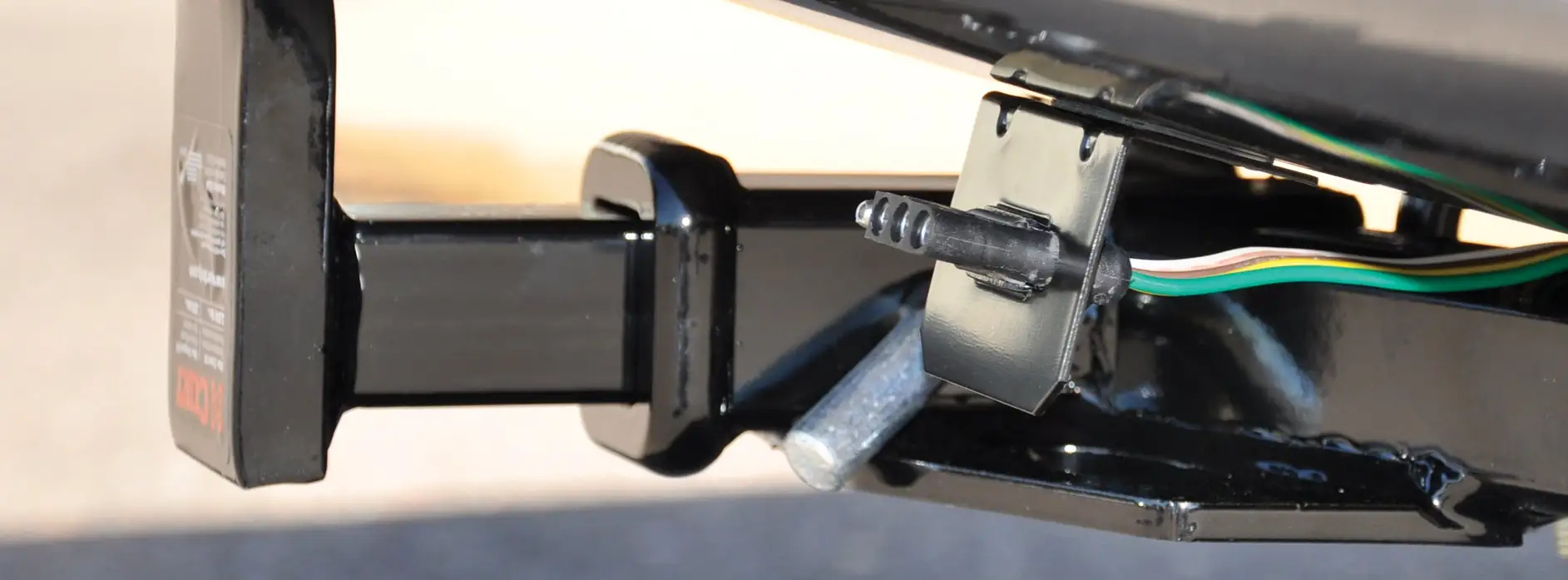The Ultimate Guide to 4-Wire Trailer Connectors
If you’re not an electrician, it might seem like a daunting task to outfit your boat trailer, ATV trailer, or utility trailer with a 4-wire trailer connector. Don’t fret. It’s easier than you think! The 4-way flat connector is one of the most widely used systems for basic towing needs. This vital connection provides the required running lights, turn signals, and brake lights for your trailer. There is also an additional wire for grounding your electrical system.
This comprehensive guide aims to provide you with an in-depth understanding of the 4-wire trailer connector, covering everything from its basic functions to wiring, installation, maintenance, and must-have accessories. Let’s get into it!
4-Way Flat Connector Basics
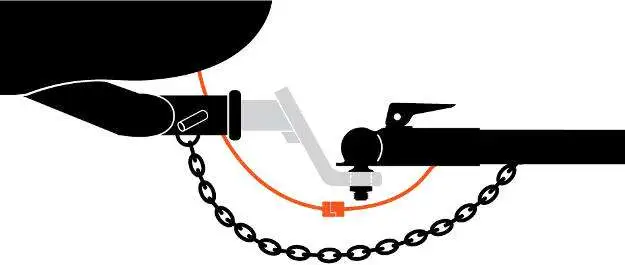

A 4-wire trailer connector, also known as a 4-way flat connector, is designed to provide a reliable connection between the towing vehicle and your trailer. It’s the most commonly found connector on boat trailers, ATV trailers, utility trailers, and other small trailers.
It’s called a “4-wire connector” because it has four separate wires within the connector that provide the connection you need for your running lights, brake lights, turn signals, and a ground connection. The connector typically features a flat, rectangular plug with four pins arranged in a row, making it easy to connect and disconnect. The 4-wire connector can also be found in a round configuration.
What Are the Functions of a 4-Way Flat?
The 4-wire connector is primarily used for basic towing setups where the trailer’s lighting needs are straightforward. A 4-way flat connector can be used for the following functions:
- Running lights: These lights illuminate the rear of the trailer, making it visible to other drivers.
- Turn signals: The left and right turn signals on the trailer match the turn signals of the towing vehicle.
- Brake lights: When the towing vehicle’s brakes are applied, the trailer’s brake lights also illuminate.
- Ground connection: Provides a common ground for the trailer’s electrical system, ensuring that all lights function properly.
This easy-to-use connector makes it ideal for use on smaller trailers or those with basic lighting requirements. For more complex trailers where additional functions may be required, you may need a 5-, 6-, or 7-wire connector.
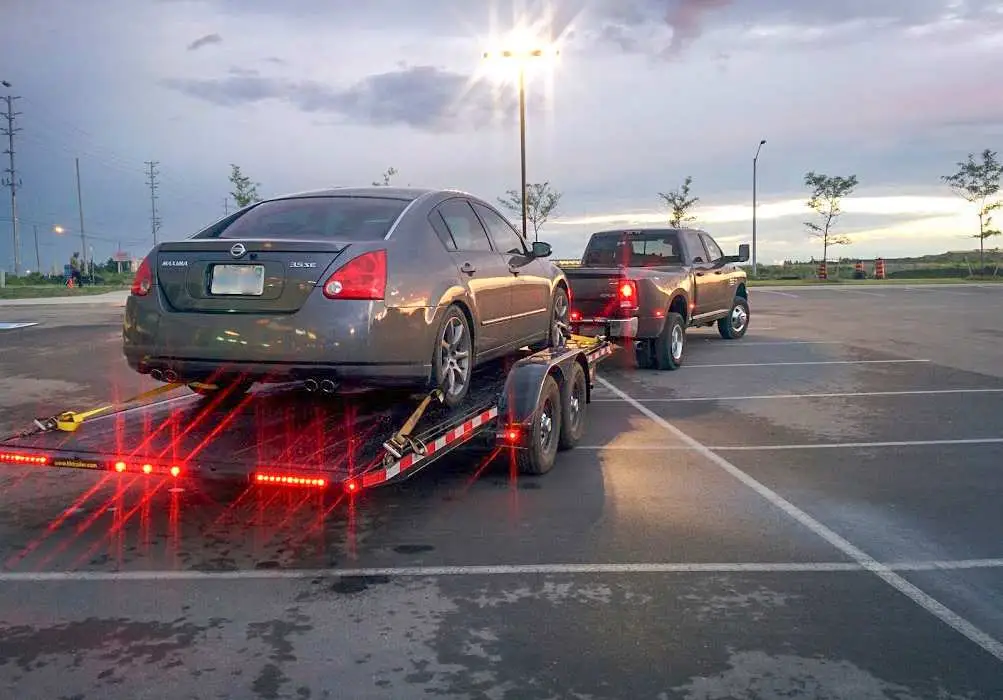

4-Way Flat Vs Other Connector Types
Knowing the difference between each type of connector and what each connector does is essential for selecting the right connector for your /towing-electrical.
- 5-Wire Connector: This connector includes an extra wire for backup lights or reverse lights. The additional wire allows the trailer’s reverse lights to operate when the towing vehicle is in reverse gear.
- 6-Wire Connector: This type adds another wire for electric brakes, which is crucial for trailers that require braking control. Electric brakes help ensure smoother stopping and are often found on larger trailers.
- 7-Wire Connector: The 7-wire connector is the most comprehensive, including wires for running lights, turn signals, brake lights, reverse lights, electric brakes, and auxiliary power. This connector is ideal for larger trailers, RVs, or those with multiple electrical functions.
4-Way Flat Vs 4-Way Round
Although the 4-way flat and 4-way round connectors look completely different, they offer the same basic wiring scheme for connecting the lights on your vehicle and trailer. Both the 4-way flat and 4-way round have green (right turn signal/brakes), yellow (left turn signal/brakes), brown (running lights), and white (ground) wires.
- 4-Way Flat: The 4-way flat connector is the most common type and features a flat, rectangular plug with four pins arranged in a row. This design is simple, easy to use, and is typically found on most passenger vehicles and smaller trailers.
- 4-Way Round: The 4-way round connector, while less common, features a round plug with four pins arranged in a circular pattern. This type is often used in specific applications or older vehicles and trailers. It provides a similar function to the 4-way flat but has a different physical design.
How to Wire a 4-Way Flat Connector
Wiring a 4-way flat on both the vehicle and trailer side is crucial for ensuring that your trailer’s lights function properly when you’re on the road. Let’s take a look at the function of each wire color does, steps for wiring your trailer, and the options you have for equipping your vehicle with a 4-wire connector.
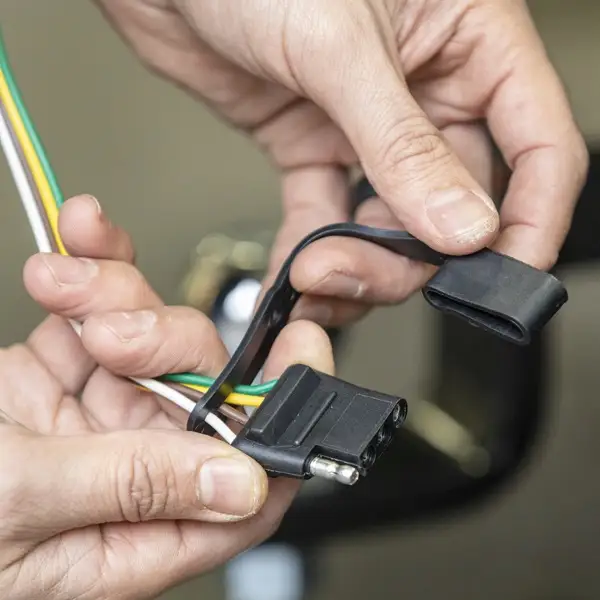

What Do the Colors Do & What Do They Mean?
Each wire on a 4-way flat connector is responsible for a specific function. It’s important to know what each color means and what each wire does before you start wiring your vehicle and trailer.
- Green: The green wire powers your right turn signal and brake lights; that is, the right taillamps on your trailer. It ensures they activate when you turn on your right turn signal or apply the brakes.
- Yellow: The yellow wire powers your left turn signal and brake lights; that is, the left taillamps on your trailer. It ensures they activate when you turn on your left turn signal or apply the brakes.
- Brown: The brown wire provides power for your running lights. This includes the taillights and any side markers the trailer may be equipped with.
- White: The white wire establishes a common ground for your trailer’s electrical system. It should be properly grounded at the trailer tongue or frame.
| Color | Function |
| Green | Right turn signal / brakes |
| Yellow | Left turn signal / brakes |
| Brown | Running lights / taillights |
| White | Ground |
How to Wire a 4-Way Flat Connector
Wiring a 4-way flat on both the vehicle and trailer side is crucial for ensuring that your trailer’s lights function properly when you’re on the road. Let’s take a look at the function of each wire color does, steps for wiring your trailer, and the options you have for equipping your vehicle with a 4-wire connector.


Each wire on a 4-way flat connector is responsible for a specific function. It’s important to know what each color means and what each wire does before you start wiring your vehicle and trailer.
- Green: The green wire powers your right turn signal and brake lights; that is, the right taillamps on your trailer. It ensures they activate when you turn on your right turn signal or apply the brakes.
- Yellow: The yellow wire powers your left turn signal and brake lights; that is, the left taillamps on your trailer. It ensures they activate when you turn on your left turn signal or apply the brakes.
- Brown: The brown wire provides power for your running lights. This includes the taillights and any side markers the trailer may be equipped with.
- White: The white wire establishes a common ground for your trailer’s electrical system. It should be properly grounded at the trailer tongue or frame.
How to Wire a 4-Way Flat Trailer Connector
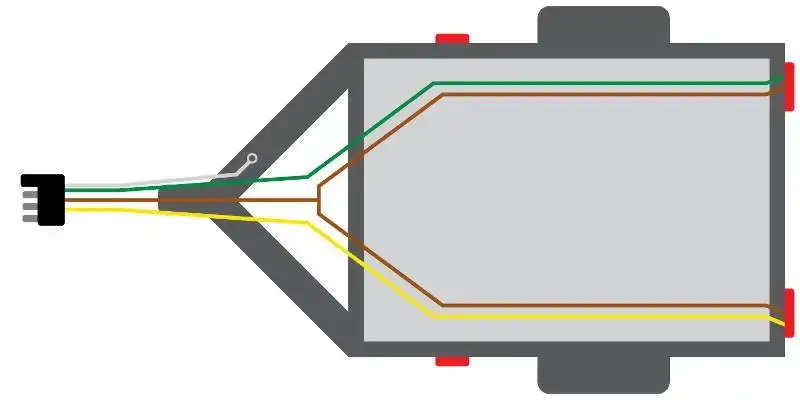

Rewiring a trailer involves taking out the old wiring and trailer lights, running the new wiring harness through the trailer frame, installing new trailer lights, and then testing the lights to make sure everything works. While that may seem like a lot of work, rewiring your trailer can be done by following these eight steps. If you want a more in-depth look at how to rewire your trailer, you can view our comprehensive guide: Rewiring a Trailer in 8 Simple Steps.
- Sketch a trailer wiring diagram
- Remove the old trailer lights and wiring
- Lay out the new wiring
- Mount the ground wire
- Install the marker lights
- Clip the wires onto the frame
- Install the taillights
- Test the trailer lights
Equipping Your Vehicle with a 4-Way Flat Connector
To safely tow a trailer, your vehicle needs a trailer wiring harness to connect the trailer's taillights, turn signals, brake lights, and other electrical systems.
If your vehicle doesn't have working trailer wiring, there are several options to outfit your vehicle. The three main options are custom wiring, splice-in wiring, and replacement wiring.
1.) Custom Wiring Installation
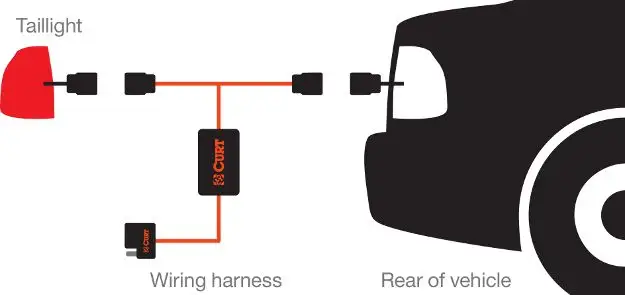

Custom wiring is the best choice for setting up a trailer wiring connection on your vehicle. A custom wiring harness or “T-connector” is designed specifically for your vehicle and provides a standard connector output (typically a 4-way flat). The best part? It plugs in directly without the need for any splicing.
All CURT custom wiring comes with the exact components needed for a complete installation on the vehicle, including vehicle-specific plugs and an electrical converter, if needed.
2.) Splice-in Converter
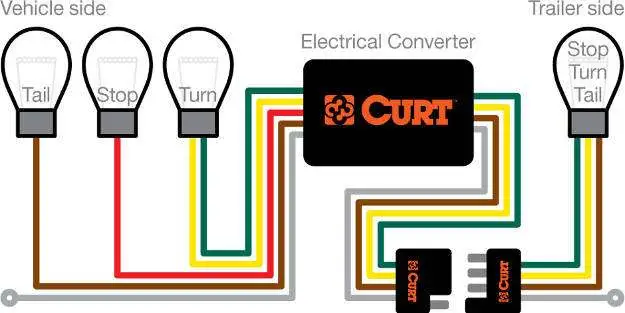

If a custom wiring harness isn't available for your specific vehicle, you might need a taillight converter to set up the right trailer light connection.
A taillight converter, also known as an electrical converter, connects to your vehicle’s wiring, and provides a standard trailer plug, like a 4-way flat connector. It simplifies your vehicle’s complex wiring, so it is compatible with your trailer’s wiring system.
3.) Replacement Vehicle & Trailer Plug Wiring
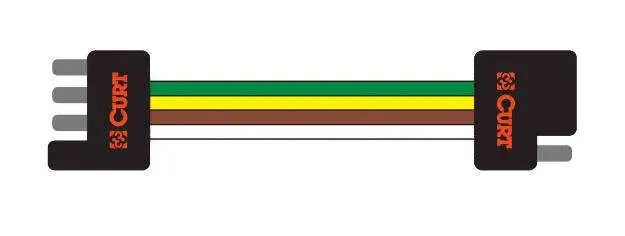

If the trailer plug wiring on your vehicle or trailer is damaged or not functioning properly, you can easily replace it with a CURT splice-in plug or socket.
CURT offers both plugs (for the trailer side) and sockets (for the vehicle side) in all standard formats. These can be spliced into your existing wiring to restore connection and get your lights working again.
4-Way Flat VS Other Connectors
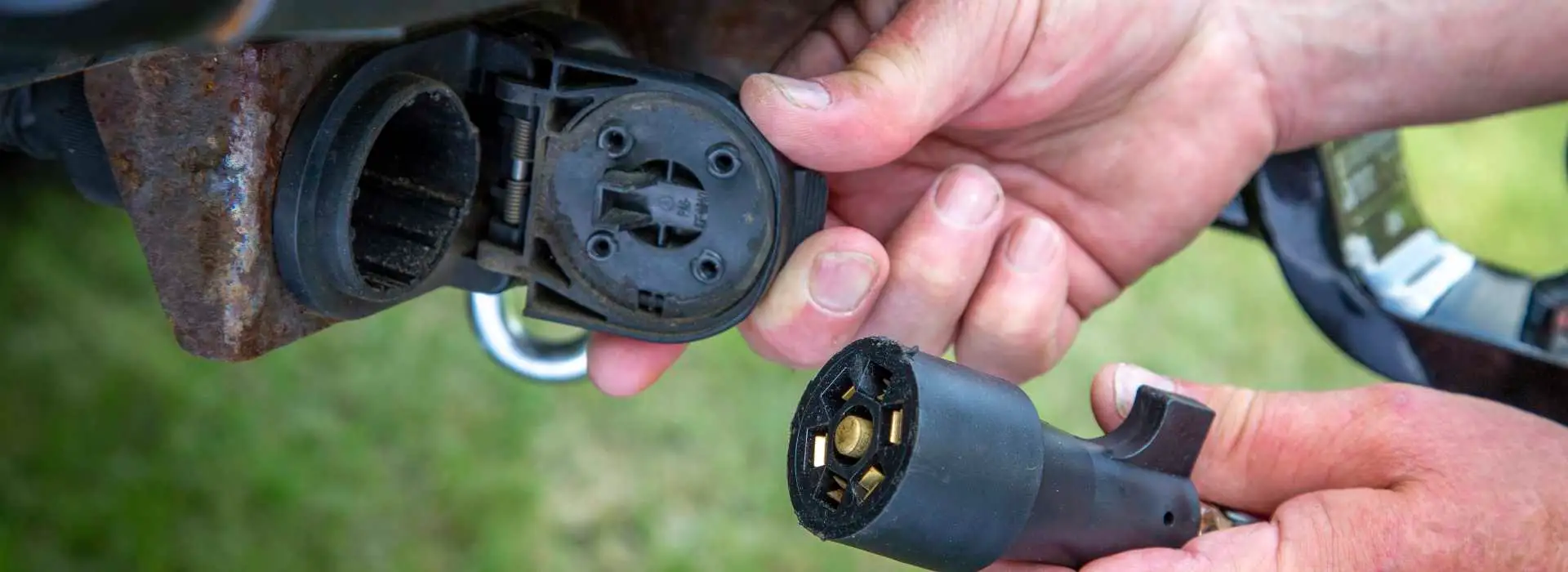

When towing a trailer, it’s crucial to ensure you have a proper wiring connection between your vehicle and trailer for safe operation. Different wiring configurations—such as the 4-way flat, 5-way flat, 6-wire, and 7-wire connectors—serve various functions and fit different needs depending on whether you’re towing a utility trailer, boat trailer, or RV.
4-Way Flat Connector vs. 5-Way Flat Connector
A 5-way flat connector is a type of trailer wiring plug that provides additional functionality compared to a basic 4-way flat connector. It is designed for trailers that have reverse lights in addition to the standard lighting setup.


4-Way Flat Connector
- Green: Right turn signal / right side brake lights
- Yellow: Left turn signal / left side brake lights
- Brown: Running lights / taillights
- White: Ground


5-Way Flat Connector
- Green: Right turn signal / right side brake lights
- Yellow: Left turn signal / left side brake lights
- Brown: Running lights / taillights
- Blue: Reverse lights
- White: Ground
The 4-way flat connector is designed for basic trailer lighting needs. It includes green, yellow, brown, and white wires. This connector is ideal for light-duty trailers that don’t require additional wiring functions. Its primary advantages are its simplicity and cost-effectiveness. It’s easy to install and generally less expensive than more complex systems. The 4-way flat connector is best suited for utility trailers, small boat trailers, and other light-duty trailers where electric brakes or reverse lights are not needed.
The 5-way flat connector adds an extra function to the basic 4-way setup with a green, yellow, brown, blue, and white wires. This additional blue wire supports reverse lights, making the 5-way connector suitable for trailers that have this feature. It enhances safety and maneuverability when backing up, which is particularly useful for trailers with reverse lights. While it offers more functionality than the 4-way flat connector, it remains relatively simple and cost-effective. It is ideal for medium-sized trailers that include reverse lights but do not require additional power sources or complex features.
4-Way Flat Connector vs. 6-Wire Connector
A 6-wire trailer connector incorporates additional functionality compared to a 4-way or 5-wire connector. In addition to your basic trailer lighting setup, the 6-wire connector adds an auxiliary wire for powering other on-board systems and a wire for electric brakes.


4-Way Flat Connector
- Green: Right turn signal / right side brake lights
- Yellow: Left turn signal / left side brake lights
- Brown: Running lights / taillights
- White: Ground


6-Wire Connector
- Green: Right turn signal / right side brake lights
- Yellow: Left turn signal / left side brake lights
- Brown: Running lights / taillights
- Blue: Electric brakes
- Red / Black: 12V lead / auxiliary power
- White: Ground
The 6-wire trailer connector expands functionality beyond the 4-way and 5-way connectors with an additional red or black wire. This connector includes wires for electric brakes and an auxiliary power source, making it ideal for trailers with additional electrical needs. It supports features such as battery charging or powering extra lights, making it suitable for larger RVs, horse trailers, or trailers with onboard batteries and complex electrical systems. The 6-wire connector offers enhanced functionality and is designed for trailers that require more than just basic lighting.
The 4-way flat connector only supports basic lighting and ground functions, whereas the 6-wire connector adds the capability for electric brakes and auxiliary power. This means that while the 4-way flat connector is sufficient for simple setups, the 6-wire connector is necessary for more advanced trailers that require additional electrical support. The 6-wire connector provides increased versatility but also comes with added complexity and poetntially higher costs.
4-Way Flat vs. 7-Wire Connector
A 7-wire trailer connector is designed for more advanced trailer wiring needs, offering comprehensive functionality compared to simpler connectors.


4-Way Flat Connector
- Green: Right turn signal / right side brake lights
- Yellow: Left turn signal / left side brake lights
- Brown: Running lights / taillights
- White: Ground
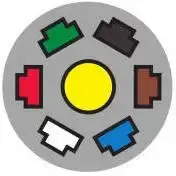

RV Blade 7-Pin Traditional Connector
- Green: Taillights / running Lights
- Yellow: Reverse Lights
- Brown: Right turn signal / brake lights
- Blue: Electric brakes
- Red: Left turn signal / brake lights
- Black: 12V lead / auxiliary power
- White: Ground


RV Blade 7-Pin SAE Connector
- Green: Right turn signal / brake lights
- Yellow: Left turn signal / brake lights
- Brown: Taillights
- Blue: Electric brakes
- Orange: 12V lead / auxiliary power
- Grey: Reverse lights
- White: Ground


Round 7-Pin Connector
- Green: Right turn signal / brake lights
- Yellow: Left turn signal / brake lights
- Brown: Taillights
- Blue: Electric brakes
- Red: 12V lead / auxiliary power
- Black: Reverse lights
- White: Ground
The 7-wire connector supports a full range of electrical functions, including advanced features like reverse lights, electric brakes, and auxiliary power. It is particularly useful for heavy-duty and specialized trailers such as large RVs, boat trailers, or horse trailers with complex electrical systems.
The 4-way flat connector provides basic lighting and ground functions, while the 7-wire connector covers all the functions of the 4-way and adds extra capabilities. The 7-wire connector’s versatility makes it suitable for trailers with multiple electrical requirements, including additional power needs and advanced features. It is ideal for heavy-duty and specialized trailers but comes with increased complexity and cost. The 7-wire connector is the most comprehensive option but may be overkill for simpler trailer setups where the 4-way flat connector suffices.
Tips for Connecting Your Vehicle and Trailer for Towing
Properly connecting your trailer to your vehicle is crucial for safe and reliable towing. Here are some tips to ensure a secure connection:
- Keep the wiring elevated and secured to prevent damage from road debris or other hazards.
- Ensure that the connectors are fully engaged to prevent loose connections and intermittent failures.
- Check that the wiring isn’t pinched by doors, the trailer frame, or other components.
- Provide enough slack in the wiring to accommodate turns and movements without pulling or stressing the connections.
- Check the connectors and wiring for signs of wear, corrosion, or damage.
Storage Tips & Tricks
Proper storage of your trailer wiring harness can extend its lifespan and ensure it remains in good condition. Follow these tips for effective storage:
- Store the harness inside your trunk or cargo area to reduce the risk of damage from road debris, inclement weather, and other obstacles on the road.
- Make sure the harness is not in a position where it could be pinched by doors or other components.
- Use dust covers to protect the connectors from dirt, moisture, and corrosion.
- Keep the connector off the ground to help prevent damage and reduce the risk of it getting snagged or dragged.
Maintenance Tips & Tricks
Regular inspections and maintenance can help catch issues early and prevent problems on the road. Follow these maintenance tips to help keep your wiring system in working order:
- Use a handheld wire brush or electrical cleaner to remove dirt, grime, or corrosion from the pins and sockets.
- Disconnect the vehicle and trailer plugs when not in use to help prevent corrosion and accidental damage.
- If the connectors become damaged or rusty, replace them with new splice-in components to maintain a reliable connection.
Must-Have Accessories
Having the right accessories can enhance the functionality and longevity of your 4-wire trailer connector. Consider these must-have accessories for your towing setup:
- Dust caps protect the connector from dust, dirt, and moisture when not in use. This helps prevent corrosion and ensures a clean connection.
- Mounting brackets secure the connector in a fixed position, preventing it from moving or getting damaged.
- Magnetic snap adapters provide a convenient way to connect and disconnect the trailer wiring quickly and easily. The magnetic design allows for a secure and straightforward connection.
Having a basic understanding of your 4-wire trailer plug is essential for a smooth and safe towing experience. Whether you’re setting up a new towing system, or maintaining an existing one, the knowledge you’ve gained here will help keep your towing system in excellent condition and you safe on the road. Safe travels and happy towing!
Disclaimer: These photographs, recommendations, and approximations are intended for demonstration purposes only and do not reflect the specifications of any particular tow vehicle, recreational vehicle, or trailer. Always consult the manufacturer’s Owner's Manual.
 ARIES
ARIES  CURT
CURT  LUVERNE
LUVERNE  UWS
UWS 



